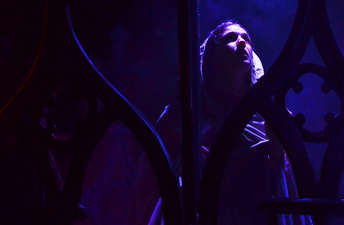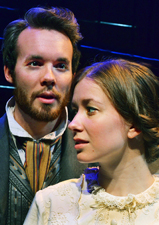From Chicago Theater Beat
Lifeline offers a mesmerizing mystery about identity
September 18, 2012
By Katy Walsh
THREE-AND-A HALF STARS
As the leaves change and the temperature drops, I long to curl up with a good book. I want to be completely engrossed in another world, another time, another life. With all the multiple distractions vying for my attention, *curling up* turns into stolen reading moments: a chapter during the drying cycle, a few pages on the bus, a paragraph at bedtime. The less-than-immersion experience is detaching and dissatisfying. If I really want to curl up with a good book, I’ve found Lifeline Theatre is my best bet.
Lifeline Theatre presents the world premiere of The Woman in White. Laura falls for her art teacher, Walter. But she is betrothed to Sir Percival Glyde. So, she honors her deceased father’s pledge and marries Sir Percival. Too late, she realizes her marital arrangement was all about money. She is the prize in a collusion by the men she trusted. How does she escape this marital trap? Who can she trust? What secrets will kill? Death, drugs and dementia will change everything. The Woman in White is an intriguing mystery about identity.
The marital team of Robert (adapter) and Elise Kauzlaric (director) bring this gothic thriller, penned by Wilkie Collins, to the stage. Robert masterfully condenses the plethora of information into tasty morsels. He keeps the dialogue crisp. Robert often uses letters read by one character to segue into a flashback performed by other characters. Elise takes Robert’s script and streamlines the action. Elise fluidly paces scene transitions by effectively using every space of the iron-rod, functional and whimsical set by Alan Donahue. The scenery gets the shrouded gloom treatment with fog, lightening, thunder and fire by the design team (Kevin Gawley’s lighting and Christopher Kriz’ sound). And Violence Designer Greg Poljacik orchestrates gasp-worthy incidents with unexpected and authentic fight scenes. All the essential elements are present for bestseller entertainment. And under Elise’s direction, this talented ensemble is bound and determined to captivate.
The entire cast pulls the audience into the tangled heap of secrets and compels us to sort out the facts. In the lead, Maggie Scrantom (Laura/Anne) plays both her parts with distinction. In one scene, Scrantom is a lovely but tortured bride. Moments later, she is a deranged escapee. Even physically, Scrantom goes from sweet demure to gnarled loon. Anchoring the show as the primary narrator, Lucy Carapetyan (Marian) provides the sensibility factor. Carapetyan endears with her sisterly commitment. A dashing Ryan-Reynolds-doppelganger, Nicholas Bailey (Walter) charms as the steadfast hero. The gallant Bailey has the certifiably swoon-worthy factor of old Harlequin romance novels. And bringing his signature scene-stealing hilarity, Christopher M. Walsh, no relation, (Count) plays haughty and cruel with mustache twirling elegance.
Have I read any good books lately? Yes! I curled up with one at Lifeline Theatre yesterday. The Woman in White is the perfect Autumn getaway!
From Time Out Chicago
September 20, 2012
By Kris Vire
THREE STARS
Whether or not you’ve read the source material, two aspects of Wilkie Collins’s 1859 detective novel come through loud and clear in Robert Kauzlaric’s new adaptation: the original’s serialized publication and its epistolary format. Characters in Collins’s complex, sensationalized tale of beautiful innocent Laura Fairlie (Maggie Scrantom) and her mysterious white-clad doppelgänger (Scrantom again) are constantly relating new information to one another via post, and there’s a new mini cliff-hanger every other minute or so.
Walter Hartright (Nicholas Bailey), a dashing young artist, is retained to provide drawing lessons to Laura and her doting spinster half-sister Marian (Lucy Carapetyan). Walter finds Laura the spitting image of the raving woman in white with whom he’s just had a rattling encounter; he and Laura fall in love, but she’s promised to one Sir Percival Glyde (Robert Kauzlaric). The connections among Glyde, his menacing associate Count Fosco (Christopher M. Walsh) and Laura and her look-alike, and the necessity of Walter and Marian to come to Laura’s rescue, flesh out the pulpy tale.
Elise Kauzlaric’s staging employs clear, creative use of Alan Donahue’s scenic design to delineate multiple settings, and her cast is terrific. Lifeline newcomers Bailey and Scrantom make an appealing pair (or is that trio?) of ingenues, and Carapetyan helps turn a thankless role into an independent-woman prototype. Still, the script remains a bit static, modeled as it is on the letters’ past-tense narration. The second act, following Collins in wrapping up first-act plot points one by one, feels overlong until a rousing climax.
From Windy City Times
September 26, 2012
By Mary Shen Barnidge
When the first thing we see onstage is a beautiful and distraught young woman on the run, either we are in the realm of pulp noir, or Victorian neo-gothic — in this case, early Victorian, circa 1859, its structure relying heavily on epistolary narrative, serialized episodes and long introspective soliloquies. Playgoers with well-developed cognitive stamina will embrace these elements, but those with short attention spans are probably better off sticking with Downton Abbey.
Lifeline Theatre’s stock-in-trade is the reconfiguration of literary epics to the restrictions of modern artistic practice, likewise enlightened sensibilities and the company’s elevator shaft-shaped stage. To this end, Robert Kauzlaric’s adaptation retains the motifs of Wilkie Collins’ seminal novel — geographical and meteorological phenomena reflecting its heroes’ dispositions, strict adherence to the minutiae of English legal and social codes, and a sybaritic villain with a penchant for small domesticated animals (the prototype for Sydney Greenstreet et al.). A major revision lies in the decision to have the rescue operation implemented in significant degree by a character not romantically tied to the lady-in-distress — specifically, the victim’s half-sister, the resourceful and courageous Marian, whose gender introduces a sexual element to the evil Count Fosco’s professed admiration for his adversary.
Thus, while Nicholas Bailey and Maggie Scrantom make a suitably attractive pair of sweethearts, the heavy-lifting duties rest on the spun-steel shoulders of Lucy Carapetyan as the forthright Marian, whose defiance of Christopher M. Walsh’s oily Fosco generates a David-against-Goliath frisson to induce shivers of excitement. Author Kauzlaric, stepping into the role of the ruthless Sir Percival Glyde at the last minute, delivers another of his reliable reptilian turns, while Anita Deely, Loretta Rezos, Don Bender and Greg Wenz portray an array of sharply-defined auxiliary personnel. Alan Donahue’s scenic design suggests locales ranging from shadowy urban alleys to lonely country estates, as does Victoria DeIorio’s plucked-strings score of incidental music, providing an evocative environment for labyrinthine secrets leading to desperate deeds that Elise Kauzlaric’s direction keeps briskly forthcoming.
Indeed, so briskly did the deft ensemble pace themselves on opening night (with the exception of Fosco’s too-leisurely final confession) that often continuity was sacrificed to efficiency — but the story’s individual components should soon find their correct place in the dramatic scheme to emerge a suspense-filled thriller to satisfy all-ages fans of the genre.
From Chicago Critic
Early detective tale still clues in audience
September 18, 2012
By Beverly Friend
RECOMMENDED
Although he wrote 30 novels, Wilkie Collins is best remembered for The Woman in White — and deservedly so. This Victorian melodrama, never out of print since its 1859 publication and cited as the first “sensational novel,” inspired and laid the groundwork for later detective and suspense fiction, utilizing many of the techniques of the hero/sleuth.
Adapted by Lifeline Theater ensemble Member Robert Kauzlaric, this newest incarnation captures all the twists and turns of the original via expected action enhanced by delicious monologues that echo Collins epistolary style. This version of The Woman in White provides a worthy addition to Lifeline’s dramatic specialization of original literary adaptations.
As the evil, bombastic Count Fosco, Christopher M. Walsh — a Peter Ustinov look-alike — nearly steals show with his finely delivered, uninterrupted speeches. In a story with as many layers as the preverbal onion, Walsh’s skill at varied — often quite humorous — presentations prevent the plot from degenerating into more tell than show. There is plenty of show, but the telling — which covers time lapses and behind-the-scenes episodes — skillfully moves the complicated story along.
The story (in a nutshell) deals with not one, but two rather fragile women garbed in white (both played by winsome, virginal Maggie Scrantom): Anne Catherick has just escaped from an insane asylum; Laura Fairlie needs to escape from her disastrous, arranged marriage. Two bonds link these women: an amazing physical resemblance, and their victimization by fortune hunter Sir Percival Glyde (Kauzlaric) and his opera-loving sidekick Fosco.
Laura’s practical, forthright half sister Marian Halcombe (Lucy Carapetyan) and the sincere, worthy young man who truly loves her, art teacher Walter Hartright (Nicholas Bailey), seek to protect the girls — but the odds are stacked against all three in this dark tale of love, marriage, greed and a mysterious secret.
The story was partially inspired by an 18th century tale of abduction and wrongful imprisonment and includes two of Collin’s favorite themes: mistaken identity and the misuse of lunatic asylums. The cast was outstanding. Greg Wenz opened the show as colorful, pixyish Professor Pesca, emoting with a wonderful Italian accent and determined to repay Hartwright for saving his life. Don Bender, Anita Deely, and Loretta Rezos, in multiple roles, were uniformly first-rate as is the staging. Lifeline never ceases to amaze with what it can accomplish in such limited space — from calm drawing room to amazing church conflagration.
The Woman in White, which has inspired theater, film, TV and everything from an Andrew Lloyd Weber musical to a comic strip, now takes a worthy place on the Chicago Theater Scene.

























